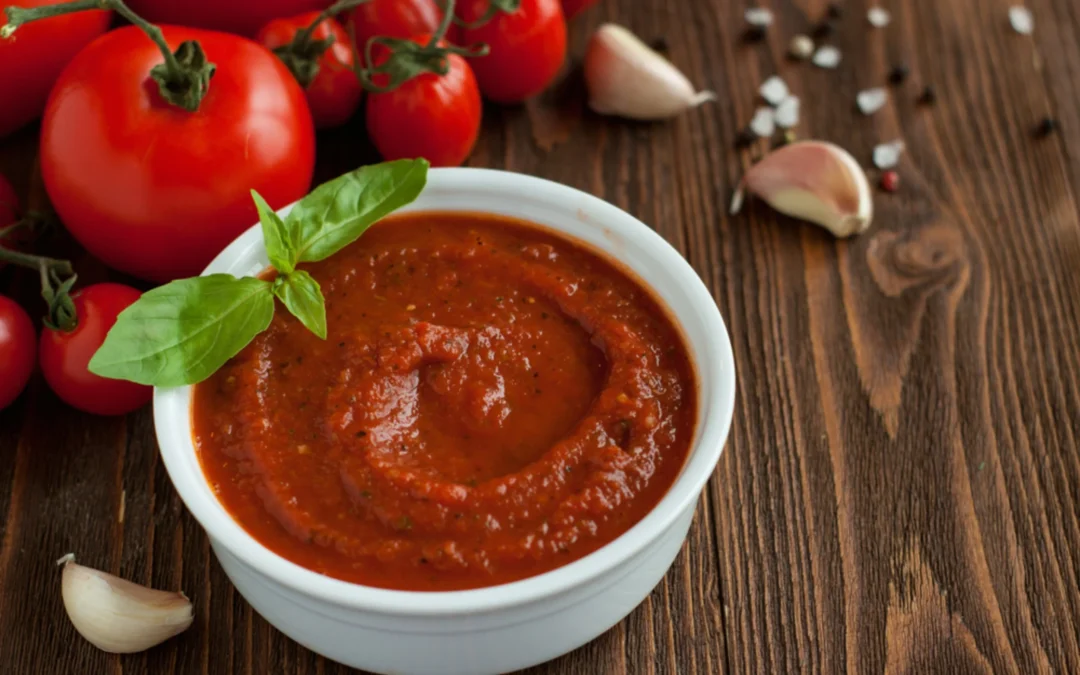A sauce forms the heart of any pizza, influencing every bite with its delicious, tangy zest. An exquisite homemade pizza sauce is integral, acting as the canvas upon which all other ingredients come alive.
And what could be fresher, more authentic than a homemade one? It embodies the traditional Italian essence while guaranteeing the absence of preservatives and unwanted chemicals commonly found in store-bought variants.
History of Pizza Sauce
Pizza sauce praises its roots in Italy. Here, the simplistic brilliance of crushed tomatoes, seasoned with salt, garlic, and the finest herbs, took birth. The allure of this sauce wasn’t confined merely to Italy.
Its charm transcended borders, influencing global cuisines and morphing to suit varied palettes while preserving its authentic core.
Read More About Care of Pizza Stone
Key Ingredients for a Perfect Pizza Sauce
- Tomatoes: The essence of any pizza sauce recipe lies in selecting the right tomatoes. Opt for fresh, ripe ones or premium-quality canned tomatoes to achieve that perfect balance of tanginess and sweetness.
- Olive Oil: An ideal component, olive oil is more than just a medium for cooking. Its aromatic richness elevates the sauce’s texture, adding an unmistakable Italian touch.
- Spices and Herbs: The secret behind a sauce’s robust flavor lies in the delicate interplay of spices and herbs. Oregano, basil, garlic powder, and a pinch of red pepper flakes are indispensable.
- Sweeteners: Tomatoes inherently carry a degree of acidity. A spoonful of sugar or a natural sweetener can harmonize this, giving your sauce a well-rounded taste.
Benefits of Making Pizza Sauce at Home

There’s an undeniable charm in concocting a fresh batch of pizza sauce in one’s kitchen. You gain unparalleled control over ingredients, catering to dietary restrictions or preferences.
The freshness of homemade sauce is palpable, adding an extra layer of depth to pizzas. Moreover, it is cost-effective and permits endless culinary experimentation, letting you tweak flavors to your family’s liking.
Tools and Equipment Needed
- Saucepan: A good quality saucepan ensures even cooking. Look for one with a heavy base to avoid burning.
- Blenders vs. Food Processors: While blenders give a smoother finish, food processors allow a chunkier consistency. The choice is a matter of personal preference.
- Utensils: A wooden spoon for stirring, a hand whisk for blending, and a container for storing are essential.
Step-by-Step Guide to the 15-Minute Recipe
Commence by prepping your ingredients.
- Fresh tomatoes should be finely crushed, while canned ones can be directly used.
- Heat olive oil, sauté garlic until golden in a saucepan, and add tomato paste followed by crushed tomatoes.
- Sprinkle seasonings, simmer, and behold as the aromas meld.
- Once done, transfer to a bowl and let it cool before refrigerating.
Common Mistakes to Avoid
- Avoid overcooking the sauce; it can make it overly thick and compromise the fresh tomato taste.
- Simmering is pivotal; a hurried job won’t extract the flavors fully.
- Lastly, use in-season tomatoes or high-quality canned ones. Inferior quality tomatoes can make the sauce bland.
Customizing Your Sauce

Homemade recipes cater to all – from vegan to vegetarian. Enhance the heat with red pepper flakes or try a pesto-infused or BBQ twist. The sauce can be as versatile as one’s imagination.
Pairing Your Sauce with Pizza Types
Whether you favor a thin crust or a deep dish, this sauce complements all. Its adaptability suits traditional pizzas as well as gourmet experiments.
Storing and Preserving Your Pizza Sauce
Upon cooling, transfer the sauce to a jar or an airtight container. Refrigeration preserves its freshness for a week. For prolonged usage, freezing is advisable. If you’re inclined towards canning, ensure proper sterilization to extend its shelf life.
Nutritional Benefits of Homemade Pizza Sauce
Tomatoes are rich in antioxidants, especially Vitamin C. Olive oil, brimming with health benefits, augments the sauce’s nutritional profile. Homemade variants allow sodium and sugar regulation, ensuring a health-conscious meal.
Ideas Beyond Pizza

The sauce’s versatility doesn’t end at pizzas. It doubles as a pasta sauce or can be incorporated into various dishes, amplifying their flavor profile.
Feedback from Pizza Lovers
Many have lauded this 15-minute Recipe for its simplicity and authenticity. Home chefs have added their twists, enriching the sauce’s flavor tapestry.
Conclusion
Crafting a homemade pizza sauce offers more than just a culinary experience; it’s a journey through traditions, an ode to authenticity. Each spoonful, bursting with flavors, is a testament to the love and care poured into it.
Frequently Asked Questions
Is there a no-cook version of the pizza sauce?
Yes, send the ingredients and let them sit for flavors to meld. However, cooking enhances the taste.
Can I add cheese directly to the sauce?
While cheese is usually added atop the pizza, incorporating Parmesan into the sauce can add depth to the flavor.
Are canned tomatoes less nutritious than fresh ones?
Canned tomatoes retain most nutrients. Ensure you choose a brand without added preservatives for best results.
How can I make a chunkier sauce?
Use a food processor for a less refined texture, or add finely chopped tomatoes towards the end of the simmering process.

